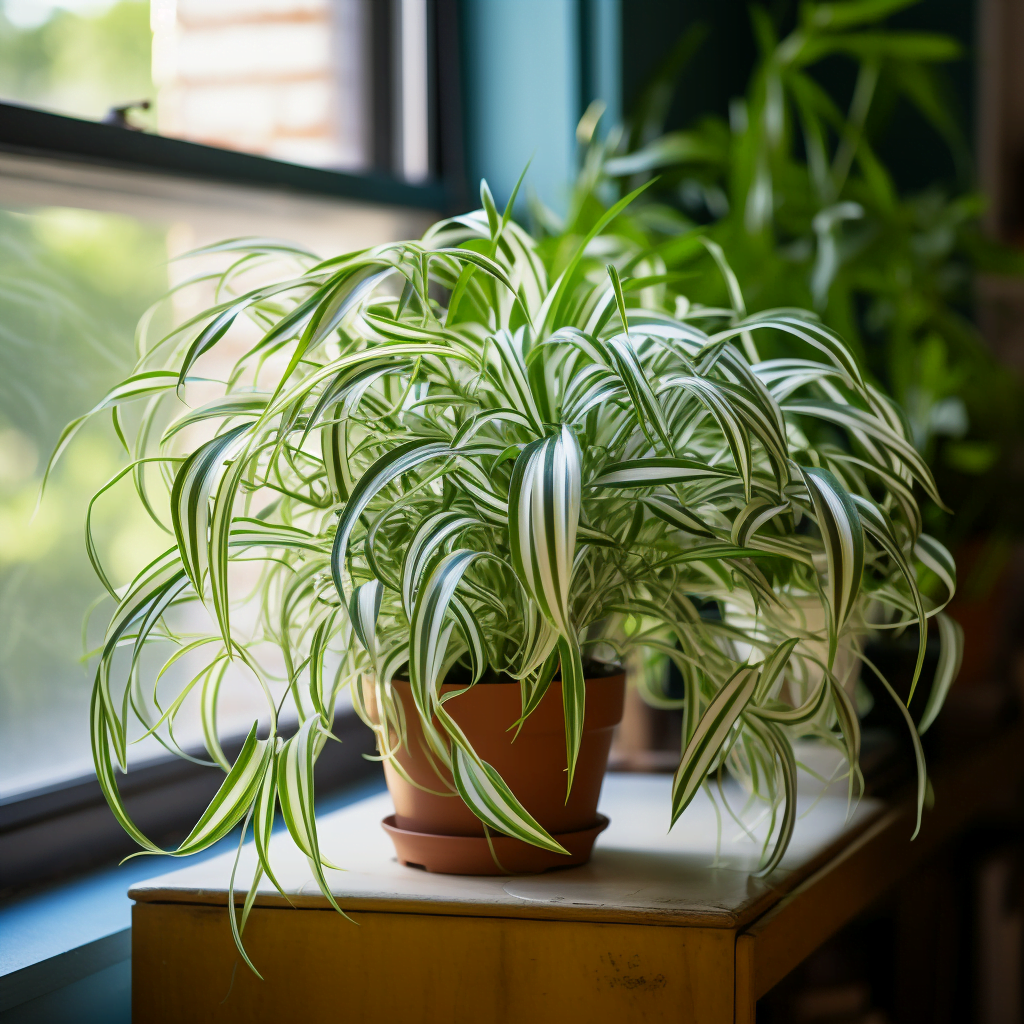4 Houseplants That Absorb Moisture Indoors – Combat Mould and Humidity Condensation Easily
Indoor Plants: Your Secret Weapon Against Condensation With Plants That Absorb Moisture
Are you tired of dealing with condensation issues in your home? Look no further than your own indoor garden. Houseplants not only bring beauty to your space, but they also have the remarkable ability to regulate humidity levels and combat condensation.
In this article, we will explore the benefits and features of specific houseplants, such as the Spider Plant, Peace Lily, Snake Plant, and Boston Fern, that excel at banishing condensation.
Discover how incorporating these secret weapons into your indoor environment can create a healthier and more comfortable living space.
Key Takeaways
- Houseplants such as Spider Plant, Peace Lily, Snake Plant, and Boston Fern can help control condensation by releasing moisture through transpiration.
- Houseplants with large leaves and high transpiration rates are most effective in reducing condensation on surfaces.
- Proper care, including adequate water and light, is essential to enhance plant transpiration and maximise their effectiveness in controlling condensation.
- While houseplants can contribute to a healthier environment and reduce condensation, they are not a solution for severe condensation issues and should be combined with structural improvements for the best results.
Houseplants That Banish Condensation
Houseplants have the ability to eliminate condensation in indoor spaces. When it comes to reducing condensation, certain houseplants are more effective than others. The best houseplants for reducing condensation include the Spider Plant, Peace Lily, Snake Plant, Boston Fern, and English Ivy.
When choosing the right houseplants for condensation control, it is important to consider their benefits and features. For example, the Spider Plant is a natural dehumidifier that is low-maintenance and adaptable to various lighting conditions. On the other hand, the Peace Lily is ideal for low-light areas and thrives in high humidity, making it effective in reducing mould and air pollutants.
When incorporating houseplants for condensation control, it is important to provide proper care, enhance plant transpiration, and consider ventilation and humidity control. While houseplants can create a healthier environment, they may not fully eliminate condensation and should be combined with structural improvements for the best results.
Benefits and Features of Spider Plant

One notable benefit of the Spider Plant is its ability to serve as a natural dehumidifier, making it an ideal choice for controlling condensation in indoor spaces. This low-maintenance plant is not only effective at reducing moisture levels but also offers several other features that make it a popular choice among plant enthusiasts.
Spider plants are adaptable to various lighting conditions, making them versatile and easy to care for. They thrive in bright, indirect light but can also tolerate lower light conditions. To care for spider plants, it is recommended to water them thoroughly when the top inch of soil feels dry and to avoid overwatering.
With its ability to purify the air by removing pollutants, the Spider Plant is a great addition to any indoor space.
Benefits and Features of Peace Lily

The Peace Lily offers a range of benefits and features that make it a popular choice for controlling condensation in indoor spaces. One of the key benefits of the Peace Lily is its ability to improve indoor air quality. This plant has been found to reduce mould, mildew, and air pollutants, creating a healthier environment.
Additionally, the Peace Lily thrives in low-light areas, making it ideal for spaces with limited natural light. It is important to note that the Peace Lily does best in indirect, bright light, so it is important to find the best lighting conditions for this plant.
With its ability to reduce condensation and improve air quality, the Peace Lily is a great choice for those looking to combat moisture issues in their indoor spaces.
Benefits and Features of Snake Plant

Snake Plant, also known as Sansevieria trifasciata, offers numerous benefits and features that make it a valuable addition to any indoor space.
Snake plants are known for their ability to absorb water vapour during the night, making them effective in reducing condensation.
They thrive in bright light and warm temperatures, making them suitable for various indoor environments.
One of the best practices for snake plant care is that they are low maintenance and only need watering once every week or two.
Additionally, snake plants are excellent air purifiers, filtering out common toxins in the home.
With their unique combination of benefits, snake plants are a popular choice for those looking to control condensation and improve indoor air quality.
Benefits and Features of Boston Fern
Boston Fern, a popular indoor plant, effectively reduces humidity levels with its lush foliage and vibrant green fronds. This tropical plant is known for its ability to tackle airborne chemicals and improve air quality. Boston Ferns thrive in high-humidity environments, making them ideal for bathrooms or kitchens.
Care tips for Boston Fern include placing it in a location with bright, indirect light and keeping the soil consistently moist. Hanging the plant from baskets or shelves allows its fronds to cascade beautifully. When it comes to Boston Fern, it’s important to avoid overwatering, as this can lead to root rot.
With its natural dehumidifying properties and striking appearance, Boston Fern is a fantastic choice for controlling condensation in your home.
Importance of Houseplants in Controlling Condensation
Houseplants play a crucial role in controlling condensation by regulating indoor humidity levels through their natural process of transpiration. They release moisture into the air, reducing condensation on surfaces.
In addition to their impact on condensation, houseplants also offer several benefits for indoor air quality. They help purify the air by removing pollutants and toxins, creating a healthier environment.
Incorporating houseplants into home decor is a great way to enhance both the aesthetic appeal and the functionality of a space. There are various ways to include houseplants in home decor, such as placing them in decorative pots, hanging them from baskets or shelves, or creating a green wall.
Strategies to Enhance Plant Transpiration
To enhance plant transpiration and maximize their effectiveness in controlling condensation, it is important to implement specific strategies.
One strategy is to provide adequate light for indoor plants, especially in spaces with limited natural sunlight. Using grow lights for indoor plants can help simulate natural lighting conditions and promote healthy growth and transpiration.
Additionally, the size of the plant plays a role in transpiration efficiency. Larger plants with more leaves have a greater surface area for transpiration, leading to increased moisture release. Therefore, incorporating plants of various sizes can enhance overall transpiration and condensation control.
Ventilation and Humidity Control
For effective control of condensation, proper ventilation and humidity control are essential. Maintaining optimal humidity levels is crucial for both plant health and condensation prevention. Houseplants play a role in regulating indoor humidity by releasing moisture through transpiration, which helps reduce condensation on surfaces. Plants with large leaves and high transpiration rates are particularly effective in this regard. However, it’s important to note that healthy plants are more efficient at transpiring moisture, so proper care is necessary.
Additionally, air circulation plays a significant role in condensation control. Using fans or periodically opening windows helps circulate air, preventing stagnant moisture buildup. Monitoring indoor humidity levels and keeping them between 30% and 50% is also crucial.
Impact of Plant Containers on Dehumidification
Proper selection of plant containers significantly influences the dehumidification process, complementing the control of condensation in indoor environments. The effectiveness of different types of plant containers should be considered when aiming for optimal dehumidification.
Choosing pots made from porous materials with drainage holes, such as terracotta, is recommended. These types of containers allow excess moisture to escape, preventing overwatering and root rot. Additionally, using a well-draining potting mix further enhances dehumidification efforts by preventing water from pooling around the plant’s roots.
The right combination of plant containers and potting mix can prevent damage to the plants themselves while increasing indoor humidity control. By incorporating plants with natural moisture-regulating properties into your home and pairing them with structural improvements, you can achieve the most effective results in combating condensation.
Limitations of Houseplants in Condensation Control
Houseplants have certain limitations in controlling condensation in indoor environments. While they can help regulate indoor humidity levels and reduce condensation on surfaces through transpiration, they are not a solution for severe condensation issues. It is important to address the root cause of condensation, such as inadequate insulation or poor ventilation.
Additionally, high indoor humidity from activities like cooking, showering, or drying laundry indoors can contribute to condensation. Therefore, integrating houseplants with other methods for effective moisture management is crucial. This can include improving ventilation, monitoring indoor humidity levels, and using dehumidifiers in especially humid environments.
Q: How do these houseplants absorb moisture?
A: These houseplants have the ability to absorb moisture from the air through their leaves.
Q: Can these houseplants help reduce humidity in the home?
A: Yes, these houseplants can help reduce humidity in the home by absorbing excess moisture from the air.
Q: Are there any specific bathroom plants that absorb moisture?
A: Yes, there are specific plants that are well-suited for bathrooms and can absorb moisture as mentioned above, such as English Ivy and peace lily.
Q: How do these plants absorb humidity?
A: These plants absorb humidity by absorbing the moisture through their leaves.
Q: What are the benefits of having these houseplants in your bathroom?
A: Having these houseplants in your bathroom can help improve air quality, reduce humidity levels, and combat mould and humidity condensation.
Q: Are there any other benefits to having these houseplants?
A: Yes, these houseplants can also help absorb excess moisture in other areas of the home, not just the bathroom.
Q: Which are the best plants to keep in your bathroom?
A: Some of the best plants to keep in your bathroom are English Ivy, peace lily, spider plant, and Boston fern.
Q: How do these plants help reduce humidity in the bathroom?
A: These plants help reduce humidity in the bathroom by absorbing moisture from the air, helping to keep mould at bay.
Q: How effective is each plant at reducing humidity?
A: Each plant varies in its effectiveness at reducing humidity, but they all provide a good choice to help control humidity and keep mould from forming.
Conclusion
In conclusion, houseplants are not just decorative additions to our indoor spaces, but also our secret weapons against condensation.
With their ability to regulate humidity levels and reduce moisture, plants like the Spider Plant, Peace Lily, Snake Plant, and Boston Fern can effectively combat condensation and its associated problems such as mould and mildew.
By incorporating these green companions into our homes and implementing strategies to enhance plant transpiration, we can create a healthier and more comfortable living environment, free from excess moisture.
Say goodbye to condensation with the power of houseplants!






